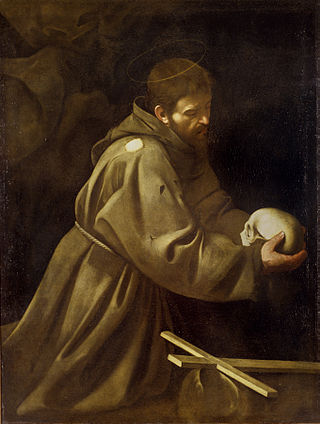The following is a list of paintings by the Italian artist Caravaggio , listed chronologically. [1]
{{cite book}}: CS1 maint: location missing publisher (link)
Michelangelo Merisi da Caravaggio, known mononymously as Caravaggio, was an Italian painter active in Rome for most of his artistic life. During the final four years of his life, he moved between Naples, Malta, and Sicily until his death. His paintings have been characterized by art critics as combining a realistic observation of the human state, both physical and emotional, with a dramatic use of lighting, which had a formative influence on Baroque painting.

The Madonna of Loreto or Pilgrim's Madonna is a painting (1604–1606) by the Italian Baroque master Caravaggio, located in the Cavalletti Chapel of the church of Sant'Agostino, just northeast of the Piazza Navona in Rome. It depicts the barefoot Virgin holding her naked child in a doorway before two kneeling peasants on a pilgrimage.

The Martyrdom of Saint Matthew is a painting by the Italian master Michelangelo Merisi da Caravaggio. It is located in the Contarelli Chapel of the church of the French congregation San Luigi dei Francesi in Rome, where it hangs opposite The Calling of Saint Matthew and beside the altarpiece The Inspiration of Saint Matthew, both by Caravaggio. It was the first of the three to be installed in the chapel, in July 1600.

Rest on the Flight into Egypt is a painting by the Italian Baroque master Michelangelo Merisi da Caravaggio, in the Doria Pamphilj Gallery, Rome. The Rest on the Flight into Egypt, like the Flight into Egypt, was a popular subject in art, but Caravaggio's composition, with an angel playing the viol to the Holy Family, is unusual.

The Young Sick Bacchus, also known as the Sick Bacchus or the Self-Portrait as Bacchus, is an early self-portrait by the Baroque artist Michelangelo Merisi da Caravaggio, dated between 1593 and 1594. It now hangs in the Galleria Borghese in Rome. According to Caravaggio's first biographer, Giovanni Baglione, it was a cabinet piece painted by the artist using a mirror.

Boy Peeling Fruit is a painting by the Italian Baroque master Michelangelo Merisi da Caravaggio (1571–1610) painted circa 1592–1593.

Mario Minniti was an Italian Baroque painter active in Sicily after 1606.

The Sacrifice of Isaac is the title of two paintings from c. 1598 - 1603 depicting the sacrifice of Isaac. The paintings could be painted by the Italian master Caravaggio (1571–1610) but there is also strong evidence that they may have been the work of Bartolomeo Cavarozzi, a talented early member of the Caravaggio following who is known to have been in Spain about 1617–1619.
John the Baptist was the subject of at least eight paintings by the Italian Baroque artist Michelangelo Merisi da Caravaggio (1571–1610).

David and Goliath, also known as David with the Head of Goliath or David Victorious over Goliath, is an oil painting by the Italian Baroque master Caravaggio. It was painted around 1600, and is held in the Museo del Prado, Madrid.

Saint Francis in Prayer is a painting from the Italian master Caravaggio, in the Galleria Nazionale d'Arte Antica in Rome.

Christ at the Column, is a painting by the Italian Baroque painter Caravaggio, now in the Musée des Beaux-Arts de Rouen, Rouen, France.

David with the Head of Goliath, dated c. 1600-1601, is a painting by the Italian artist Caravaggio (1571–1610), housed in the Kunsthistorisches Museum Gemäldegalerie, Vienna. Peter Robb believes it was acquired by the conde de Villamediana in Naples between 1611 and 1617, as Giovanni Bellori records Villamediana as having returned to Spain with a half-figure of David by Caravaggio.

Salome with the Head of John the Baptist (Madrid), c. 1609, is a painting by the Italian master Caravaggio in the Royal Collections Gallery, Madrid.

The Martyrdom of Saint Ursula (1610) is a painting by the Italian artist Caravaggio (1571–1610) and thought to be his last picture. It is in the Intesa Sanpaolo Collection, the Gallery of Palazzo Zevallos Stigliano, Naples.

Supper at Emmaus (1606) is a painting by the Italian master Caravaggio, housed in the Pinacoteca di Brera, Milan.

The Beheading of Saint John the Baptist is an oil painting by the Italian artist Caravaggio. Measuring 3.7 m by 5.2 m, it depicts the execution of John the Baptist. It is located in the Oratory of St. John's Co-Cathedral in Valletta, Malta.

Saint Jerome Writing, also called Saint Jerome in His Study or simply Saint Jerome, is an oil painting by Italian painter Caravaggio. Generally dated to 1605–06, the painting is located in the Galleria Borghese in Rome.

Penitent Magdalene is a 16th-century oil on canvas painting by Italian Baroque painter Caravaggio. The painting portrays a repentant Mary Magdalene bowed in penitent sorrow as she leaves behind her dissolute life, its trappings abandoned beside her. At the time of its completion, ca. 1594–1595, the painting was unconventional for its contemporary realism and departure from traditional Magdalene iconography. It has invited both criticism and praise, with speculation even into the 21st century as to Caravaggio's intentions. The work hangs in the Doria Pamphilj Gallery in Rome.

Fillide Melandroni was an Italian courtesan and friend of the painter Caravaggio, who used her as a model in several of his compositions.